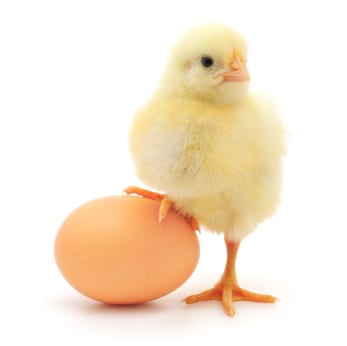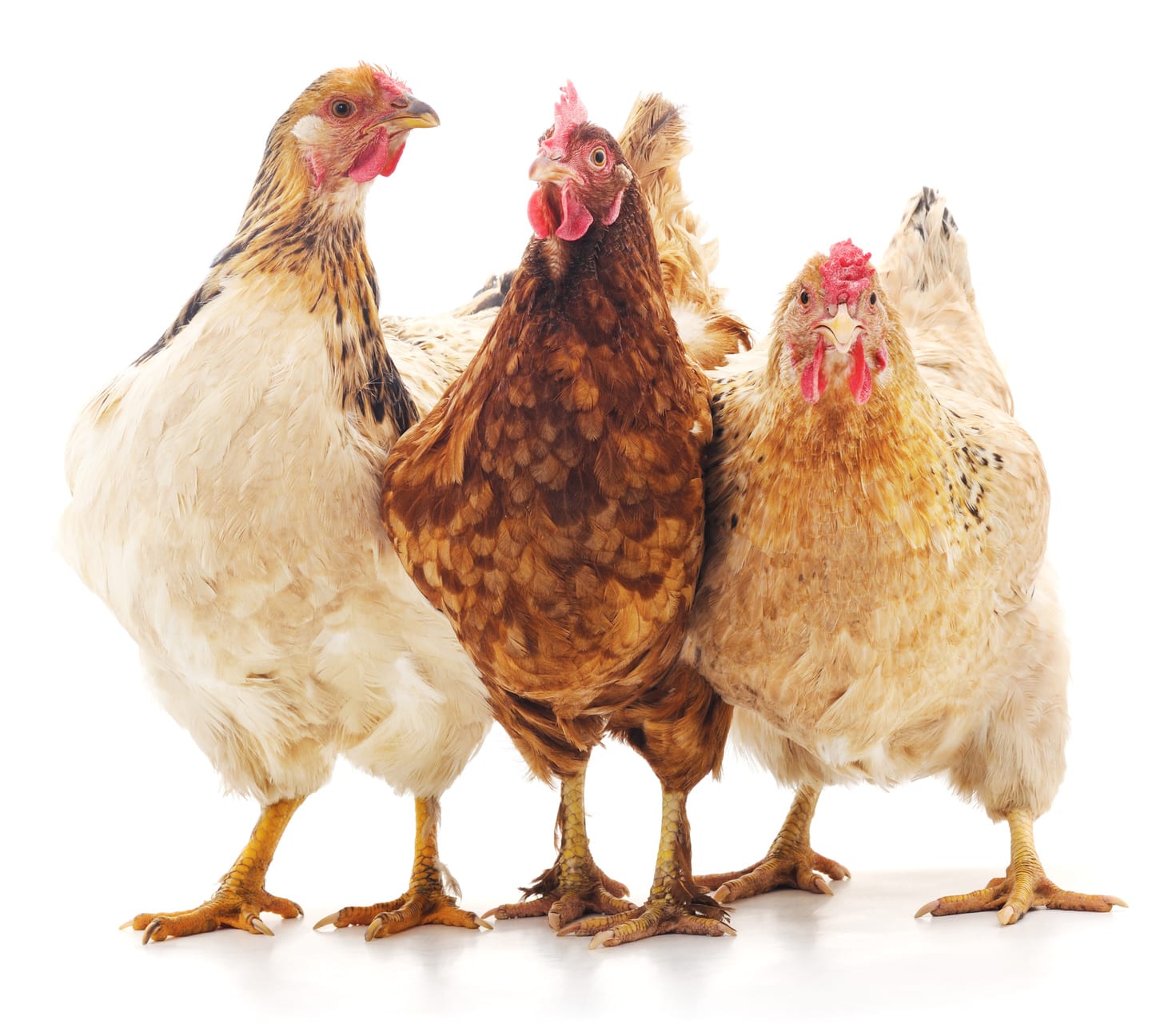
Should You Be Eating Chicken- What You Need To Consider
Here in the United States and in many developed countries, chicken has become a ubiquitous part of our regular diet, so much so that few can imagine a world without chicken. Thanks to industrialized farming, there are more chickens on earth today than any other species of bird, [1] and as a cheap, readily available source of lean animal protein, its popularity over the past several decades has risen astronomically. In 2011, Americans consumed over 81 pounds of chicken per person,[2] a staggering figure that translates into over 8 billion chickens processed a year![3] For the health conscious, chicken has been widely promoted marketed as the perfect protein source for those seeking a lean and inexpensive way to meet their protein requirements. So much so that pre-packaged skinless, boneless chicken breasts have become a must have for anyone serious about losing weight and or building muscle. That said, health and ethical concerns over the conditions in which mass produced chickens are raised have prompted many to curtail or completely refrain from eating them. It is hardly a secret that there are problems with our commercial chicken supply, but while popular documentaries and books highlight the appalling conditions in which chickens are raised, they often fail to address certain health related questions. The first being that chickens are very recent addition to the common human diet and that chickens today are radically different in terms of nutrient profiles in comparison to the chickens consumed less than a hundred years ago regardless of ‘certified organic’ or ‘free range labels’. The field of nutrition is rife with contradicting studies and information that is far from definitive. However we can observe with some degree of clarity that foraging and small scale agriculturist societies do not suffer high incidences of diet related diseases the way we do here in the West and gain critical insights by understanding how our foods today compare to dietary practices that have been in existence for thousands if not millions of years. Libel laws exist in several states against negative or disparaging remarks regarding meat and dairy products[5] and there are numerous sites and articles focused on persuading you to not eat chicken or meat of any kind. The goals of this article are nothing of the sort- only to present a comprehensive look at commercial and organic farming so as to help consumers with the questions that need to be asked before making a purchase. Thanks as always for reading and do share this article with those whom you believe would benefit from it.
Should You Be Eating Chicken- Chicken Before The Advent Of Industrialized Farming
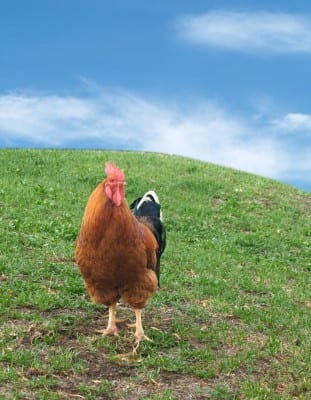
In years past, most farmers in the United States kept a few chickens in addition to whatever crops or livestock they raised. Those chickens were used mostly for eggs- creating a steady source of fats and proteins or a much sought after bargaining commodity. Since they were generally worth more while alive, hens were usually spared from the pot and it was usually after a long life of laying that the tough hens would be considered as a menu item. Young roosters- (incapable of laying eggs), were often sold to brokers supplying big city restaurants and hotels, who in turn sold chicken at prices far beyond the means of the average American at the time.[6] Thus for the better part of the 20th Century, chicken was a rare delicacy reserved for Sunday dinners and special occasions.[1,6] To give an idea how expensive chicken was before commercial mass production, in 1914 a chicken dinner at an upscale restaurant cost more than a crab, prime rib, venison or a lobster dinner.[1] Adjusting for inflation, the average price of chicken in 1923 would have been in the ballpark of $8 per pound- a price even higher than some of the most expensive certified organic poultry today.[1] That being said, while chicken may have been a common sight on American farms , they were by no means a regular part of our everyday diet and in most parts of the world where intensive farming is not practiced this is still the case.
Should You Be Eating Chicken- A Fairly Recent Addition To The Human Diet
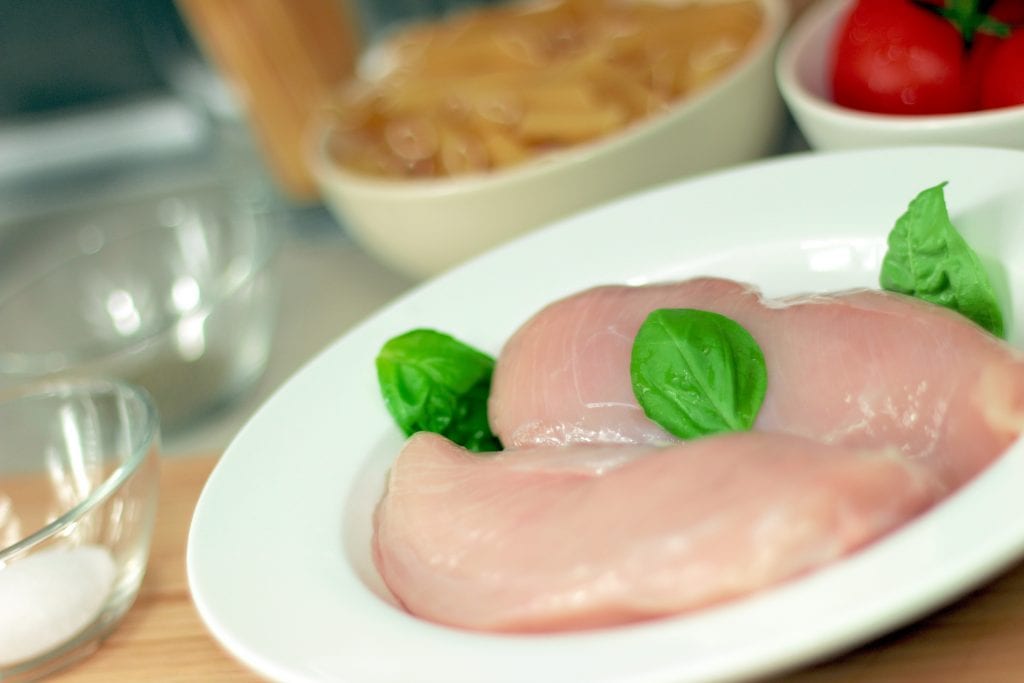
As discussed in the previous article- Meat- What You Need To Know, humans only began eating domesticated animals some 10,000 years ago.[7,8,9] A time frame that may appear to be a long time, but considering that for the better part of 2.4 million years our animal proteins foods came only from wild animal meat and wild plants, it is less than .04% of our time on the planet.[8,9] One prominent theory is that all animals, (us included), are genetically adapted to the environment in which they were formed and thus any new form of diet or lifestyle that the human genome has not had adequate time to adapt to- or is not part of our evolutionary conditioning may manifest itself in the form of chronic disease.[7,8,9,10] This theory explains the high rate of what are commonly termed ‘Western diseases’ or ‘diseases of affluence’ such as heart disease, obesity, hypertension, diabetes and other diet and lifestyle related illnesses that are not prevalent in non-Westernized societies. [7,8,9,10,11,12,13,14,15,16]
Sixty four million Americans suffer from cardiovascular disease in some form or another and if you are reading this in the United States or any other developed country, chances are that you are 500 times more likely to die from a heart attack or diet related disease than any other possible cause of death. [17,18] A sobering statistic to say the least, and an ironic one at that given that our ancestors spent millions of years without cardiovascular or any diet related disease being an issue.[7,8] Instead they worried about the very real threat of early death from events that were relatively out of their control such as accidents, malnutrition, communicable diseases, infections, wars and childbirth.[19] Events that advances in modern medicine, food availability and social structures have made comparatively rare in the developed countries of the world. Yet we have replaced those threats with a food environment where the decisions we make regarding what and how we eat will be ultimately responsible for length and quality of life.[19] While several epidemiologic studies have found correlations between higher meat intake and an increased risk of death from cardiovascular disease[66,67,68] it must be noted that all of the chicken, beef or pork consumed by individuals monitored or surveyed in these studies were raised in Westernized commercial farms.
No study has ever been able to find any such correlation between heart disease, cancer or diet related illnesses and high meat consumption among hunter gatherer or non-Westernized small scale pastoral populations who consume as much if not more animal proteins than we do in developed countries. [20, 56, 57, 58, 59, 60, 61, 62, 63, 64, 65] Many pastoral non-Western societies have chicken as an occasional part of their diets as well without ill effect, and the same observation can be made of the occasional consumption of chicken raised by subsistence farmers over the past several hundred years. That being said, the smoking gun points not to chicken or high animal protein diets but to the nutritional differences between the birds we eat here in the West today and the ones we have been eating for centuries. (See my article- How Much Protein Do You Need for more information)
Should You Be Eating Chicken-Free Living Chicken- What They Naturally Eat
Chicken might be a relative newcomer to our diet, but we have been eating wild birds for quite some time now. Chickens are a subspecies of Red Junglefowl, a tough and hardy bird that was originally domesticated in Asia, Africa and Europe not as a food source but for the purpose of staged cockfighting.[21] Their ability to eat just about anything, (under free living conditions chickens eat worms, insects, seeds and even small animals like lizards and mice[1]), and their propensity to quickly reproduce without much in the way of care made them a valued source of eggs and occasionally meat over the course of history. By the beginning of the 20th Century, almost every farm in the United States had a small flock of chickens.[6] Free ranging and searching the soil for their food, these scrappy birds did not become a major addition to the Western diet until two major events changed our supply of chicken forever- the development of vitamin supplements and World War II.
Should You Be Eating Chicken- How Vitamin Supplementation Marked The End Of Truly Free Range Chicken
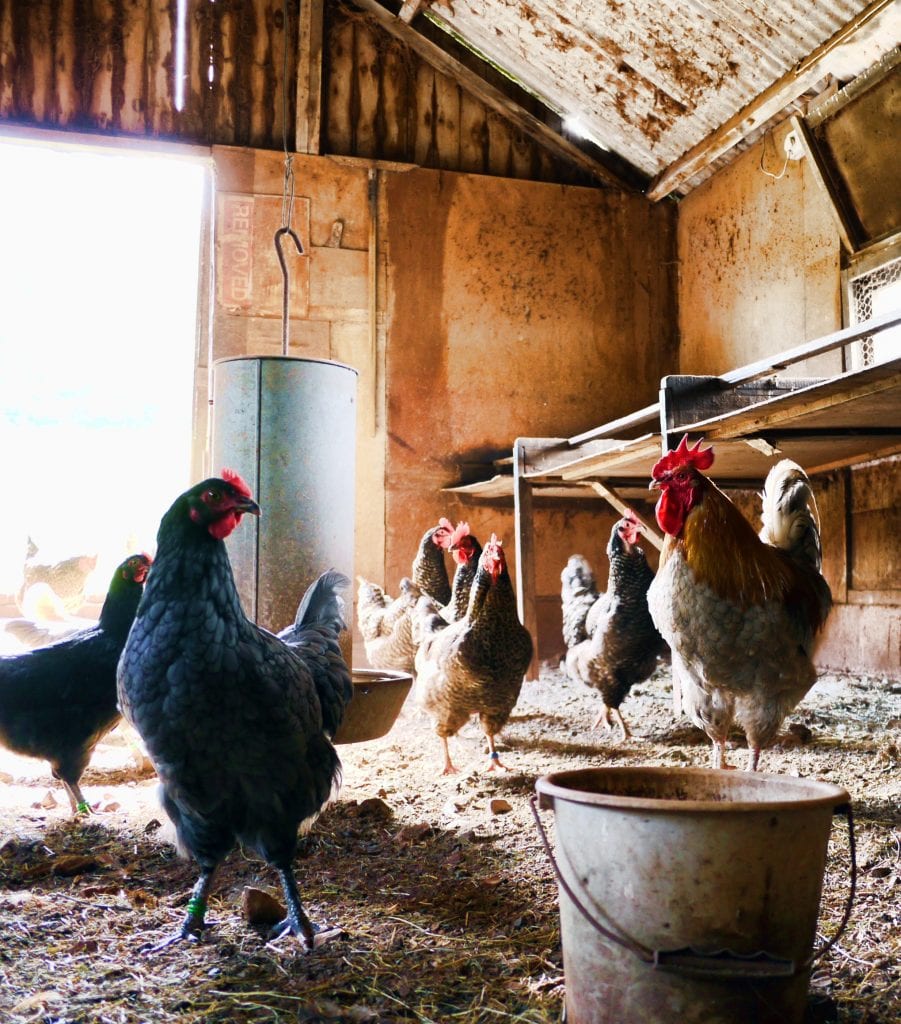
Anyone who has lived on a farm pretty much knows that chickens are for the most part a very independent bunch. Like many animals (humans included), chickens evolved in such a way that they need certain amounts of Vitamin D to ensure proper bone growth. Farmers at the turn of the century had no idea what Vitamin D was at the time- only that chickens that weren’t out in the sun for a certain amount of time didn’t grow the way they should. Consequently, chickens were always given access to the open air and could spend the better part of the day foraging for food.[1] The problem is that other animals like the taste of chicken just as much as we do, so farmers at the time had to deal with substantial losses from rats, raccoons, foxes, hawks and other predators.[1] To minimize culling of the flock from predatory animals and the elements, farmers would keep chickens in a fenced enclosure during the day so they would get the necessary sunlight and bring them into a shed at the end of the day. These conditions meant that you could only have a limited number of chickens per square acre- as they needed a lot of space to move around and so given the low supply output, the price of chicken remained exorbitant due to high demand and low supply.[1]
Advances in genetics and the increased availability of cheap corn based grains meant that farmers were able to make chickens reach market weight faster than ever before. Like humans and other animals, chickens are also not suited to a diet based around monocotyledonous grains, but by increasing the calories consumed with grain based chicken feed, farmers were able to get their chickens bigger, (and fatter), much faster than ever. In 1927 chickens were deemed ready for market after 16 weeks at 2.5lbs, but by 1941, corn based chicken feed helped produce chickens weighing in at 2.9lbs in only 12 weeks.[1,6] In spite of the reduction in time to get chickens to market weight, the supply was still relatively low as space limitations ultimately made mass production impossible. However, the discovery of Vitamin D and its role in bone growth would usher in a change in poultry farming that affects us to this day. Before vitamins were fully understood, farmers had no way of knowing why chickens died or didn’t grow properly when not given adequate access to sunlight.
[constantcontactapi formid=”0″]
With the isolation Vitamin D and the discovery that birds and other animals synthesized it from sunlight, cod liver oil (and later purified synthetic Vitamin D) was added to chickenfeed so that chickens could be kept in sheds indefinitely. Thus overcoming the previous space limitations on how many chickens a farmer could raise as there was no longer a need for an outside yard or pasture for them to roam. Having chickens in sheds at all times also reduced losses due to predators and eliminated the labor involved in getting them back into the sheds at the end of the day.[1] Like any animal, when birds are kept in one place without the ability to move freely and fed constantly, they become fatter than they would under natural circumstances. An attribute that was a huge boon to farmers. Chickens mature in a small fraction on the time it takes for cows and hogs to reach market weight and the onset of World War II saw a huge demand for animal protein for the soldiers overseas. A demand that would introduce chicken into the diet of the average American for decades to come.
World War II & The Beginning Of Mass Chicken Production
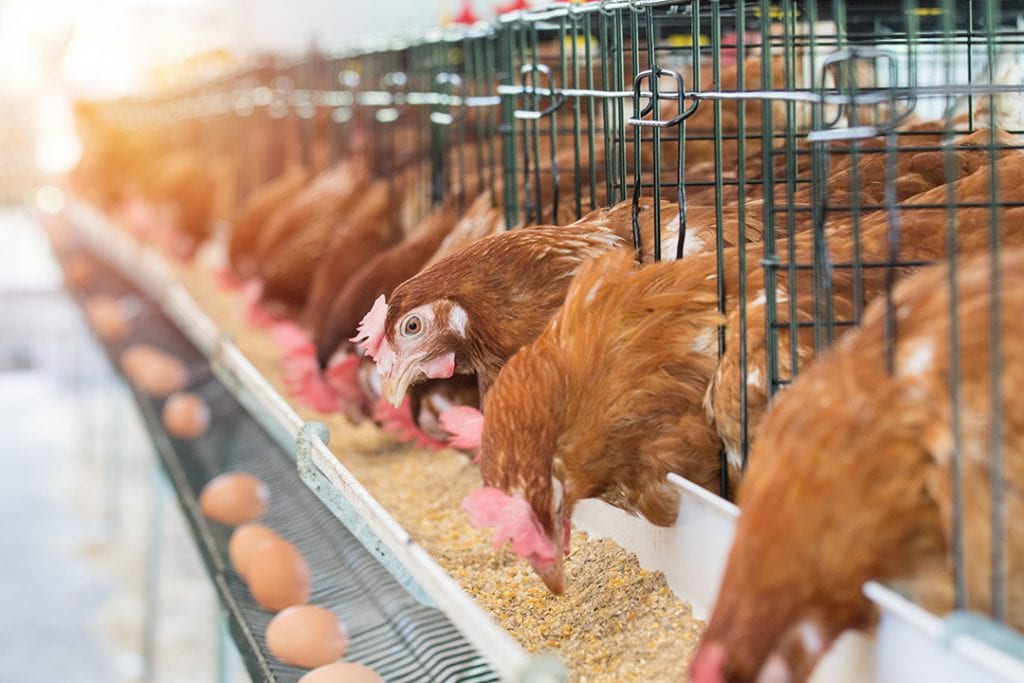
With the ability to confine large numbers of chickens in sheds and the shorter time required to get them to market weight, chicken became the de facto source of animal protein for American troops overseas during the Second World War, bringing with it a huge surge in chicken production in response to wartime demands. Other meats such as pork and beef were rationed during the war, while chicken was not, and so the combination of lowered prices (due to a much larger supply), more Americans turned to chicken as a regular common source of animal protein during the 1940’s. By the end of the war, the nation had developed a taste for chicken and production evolved into the tightly controlled commercial industry it is today.
Higher production through more intensive farming methods meant that there was more chicken on the market at any given time and given economics of supply and demand, prices fell drastically over the years. The previously limited chicken supply meant farmers with small flocks could raise enough chickens to cover their overhead expenses and still make a decent profit. With the sudden glut in the market, prices began to fall and under those circumstances the only way to possibly make a profit was to increase production levels. Something a small scale chicken farmer could hardly afford given the financial investments required up front to raise more chickens. Thus, those unable to purchase and run bigger operations were effectively priced out of the chicken farming business.
Should You Be Eating Chicken- Vertical Integration & The End Of Small Scale Farmed Chicken
Making matters worse for small farmers, in a bid to lower operating expenses in an economy of lowering chicken prices, individuals like John Tyson, Arthur Perdue and others started buying hatcheries for baby chicks, corn fields and mills to grow and make their own chicken feed and processing plants to harvest and butcher their poultry.[6,21] By controlling every step of the lives of their chickens from birth to butchering, and by combining production, processing and distribution into the same company they were able to cut out middlemen brokers, reduce costs and increase the efficiency of production in a model called vertical integration.[22] Vertical integration in the poultry industry would later become a model for the beef and pork industries as well as all modern farmed animals. Given such competition, the family farmer could not possibly hope to stand against these industrial juggernauts and by the late 1950’s these industries extended their reach by contracting smaller farmers in another key move that forever changed chicken production in the United States. Chicken companies began providing smaller farmers with young chicks straight out of their hatcheries, in addition to chickenfeed, medication and any technical assistance required to raise their birds in the most efficient manner possible. The farmer provided the sheds and the labor in return for a fee based on a feed conversion ratio where the less feed needed to bring the bird to market weight meant the more the farmer would be paid.[22] In so doing, the era of the independent chicken farmer raising their own birds and making their own decisions became a thing of the past as farmers became contracted chicken growers with no say in how chickens should be raised, harvested or marketed.
Vertical integration allowed the poultry industry to further increase production and (along with generous subsidies from the US Government), bring down the price of chicken to the point where it became an everyday item in the diets of many Americans.[35] As prices dropped and production surged, powerful marketing campaigns portrayed chicken as being leaner, (and thus healthier), than the more expensive beef and pork- setting off another huge surge in chicken consumption in the 1980’s[1] among the health conscious that continues to this day. Today the average price of chicken is somewhere around $1 per pound- a far cry from the $8 per pound (relative price) in the earlier part of the 20th Century.[1] Birds today are nearly twice the size of the ones from that period and grow to maturity in less than half the time. That being said, the chickens themselves changed significantly as well in terms of their impact on our health.
Should You Be Eating Chicken- The ‘Need’ For Antibiotics With Commercially Farmed Chicken

One issue that arises from having chickens confined to an enclosed space eating an unnatural corn based diet is that they are by no means healthy birds. Free living chickens do not naturally have a grain based monocotyledonous diet and like any other animal, have a baseline activity level requirement for optimal health. Take away their natural diet and activity levels and what you are left with is a sick, but fattened shadow of what the bird should be. Having chickens crowded together also creates the perfect breeding ground for harmful bacteria such as salmonella and campylobacter. To deal with the omnipresent threat of disease among mass farmed chickens penned together by the tens of thousands, commercial chicken growers use antibiotics and antimicrobials to reduce outbreaks that would otherwise decimate their flocks. This form of preventative antibiotic use had an unexpected side effect in that antibiotics not only increased the survival rate of chickens in unsanitary and overcrowded conditions[23], but also promoted growth by improving weight gain and feed conversion efficiency by way of their effect on microflora in the gut.[24]
The growth promoting effects of antibiotics decreases time required to get chickens to market weight which translates into higher production efficiency and higher profit margins. Yet we all pay a potentially high price with our health whether we eat chicken or not. Since the 1950’s, antibiotics have been given to chickens in low doses, in their feed, water or by injection to maximize flock yields. The problem is that this low dosage, non-therapeutic use does not eradicate dangerous bacteria, it merely suppresses it and in so doing creates an ideal environment for antibiotic resistant bacterial strains to develop. Ones that can and do pass on to us.[25,26]
How Antibiotics Use In Commercial Chickens Affects You
Antibiotics are without question, our primary defense against bacterial disease. A medical breakthrough that has saved millions of lives since they were discovered in the last century. However, since chickens and other livestock use the same antibiotics that we do, multi-drug resistant bacterial strains continue to increase.[1] As bleak as it may sound, the threat of one day contracting a food borne illness that will not respond to antibiotics increases with every passing year that there is no change in the non-therapeutic use of antimicrobials in commercial farms.[27] The World Health Organization (WHO) and the American Medical Association (AMA) are but a few prominent health organizations that list the preventative use of antibiotics and antimicrobials in farmed animals as a major contributor to the increase in antibiotic resistant food borne diseases in humans and the emergence of antibiotic resistant diseases.[28] What affects all of us- even those of us who don’t eat chicken is that studies have found that the same chemicals used in commercial farming have already leaked into the majority of American streams and rivers.[29]
In spite of recommendations against their use from almost every major medical organization, the non-therapeutic use of antibiotics in chickens and livestock continues unabated thanks to strong opposition to any bans from the members of Congress representing represent states where meat production is a central part of their economic structure.[1] Non-therapeutic antibiotic use has long been banned in the European Union and the U.S. Food and Drug Administration attempted to implement similar bans in the 1970’s but pressure from meat and pharmaceutical lobbies have made any binding legislation impossible. Bear in mind that commercial livestock in the United States alone use anywhere from 18 to 24 million tons of antibiotics a year- a figure that is eight times the total amount of antibiotics used by all the humans on the planet on an annual basis.[30] With those numbers in mind it becomes clear to see that farmed animals- not humans, make up the lion share of profits for the pharmaceutical antibiotic industry. Thus it should be no surprise that they put their considerable weight behind the already powerful American meat lobbies to see to it that there are no changes in policy that would ban or restrict the use of antibiotics in chickens and other livestock.
Chickens & Fat Content- Is Leaner Truly Healthier?
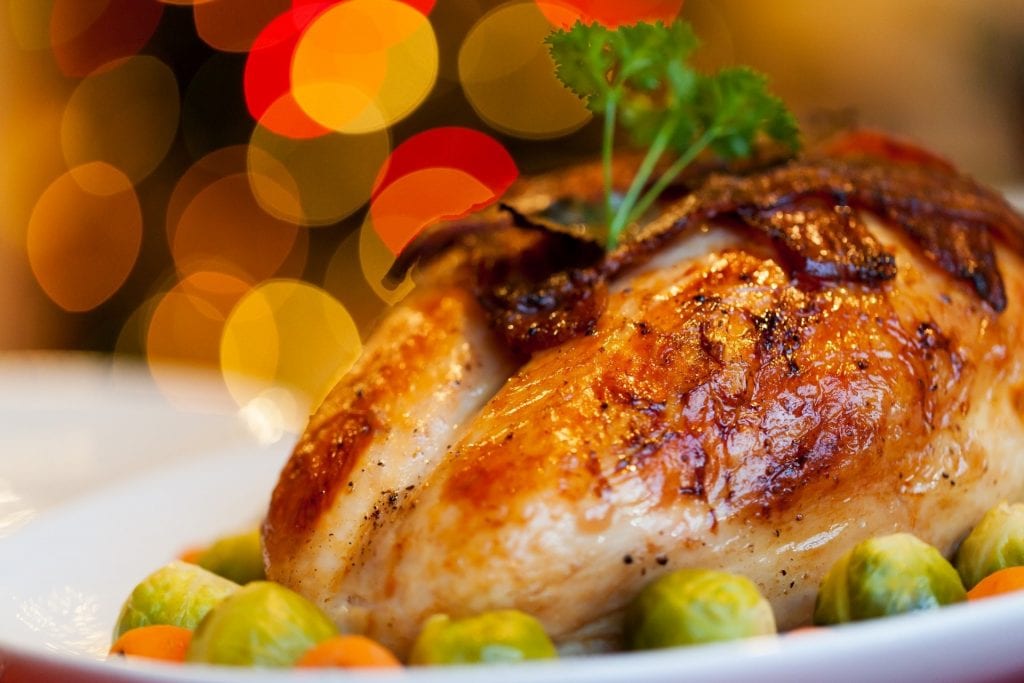
Thanks to massive public relations campaigns in the 1980’s and 1990’s presenting chicken as a leaner alternative to beef and pork, chicken sales have increased exponentially over the past few decades as consumers shifted further away from red meat and pork and towards what is perceived as a healthier alternative in the form of chicken.[1] While some chicken parts- breast meat particularly- can be lower in total fat than some cuts of beef and pork, others are higher in fat that lean cuts of meat. It’s a moot point though as insurmountable research shows that in terms of overall health, a high fat intake is not necessarily bad for your health.[58] Many hunter-gatherer societies who are generally free of the signs or symptoms of metabolic or diet related disease, have individual fat intakes between 36% and 46% of their total energy intake.[58] A value that is slightly higher than the amount of fat we eat here in the United States, as fat makes up 33% of the daily caloric intake of the average American adult.[71] Yet the average cholesterol level of studied hunter-gatherer societies is an astonishingly low 125 ml/dl with ideal ratios of low density lipoproteins to high density lipoproteins.[35] These numbers are remarkably similar to that of free living primates [35] and may very well be the norm for us as a species under natural conditions but it is far removed from the average American adult’s cholesterol levels which is 200 ml/dl.[36] We are bombarded with the concept that lower fat equals better health- but it is a flawed presumption-but one that creates a demand driven market where the price of one pack of two boneless, skinless chicken breasts cost more than an entire chicken.
Differences In Fat Profiles Between Commercially Raised Chicken & Free Living Birds
The fact is that numerous studies of non-Western populations demonstrate that it is entirely possible to consume relatively high fat diets without producing a blood plasma lipid profile that promotes the development of cardiovascular disease.[72,73] But this is possible only if there is sufficient intake of monounsaturated fats, polyunsaturated fats and an appropriate ratio of omega-3 fatty acids relative to saturated fat intake.[76] What this means is that it isn’t a question of how much animal fat you consume but what kinds of fats are present in the animals that you eat. That said, a look at the fat profiles of the free living birds and mammals consumed in non-Western societies where metabolic disease is rare clearly underscores the reality that even the best certified organic chicken from the most health conscious of supermarkets are not the same nutritionally as what is consumed in other parts of the world.[4]
The dominant fatty acids found in the muscle tissue of free living chickens are monounsaturated and polyunsaturated fatty acids (MFA’s and PFA’s) and due to their natural diet of insects and other invertebrates, they also contain high levels of the long chain omega-3 fatty acids- eicosapentaenoic acids (EPA) and docosahexaenoic acids (DHA). The advent of industrialized chicken farming radically transformed the fat profiles of chickens raised under these conditions to such a degree that they are in no way similar to the fat profiles of the free living birds and animals that we have adapted to eat over time.
Chicken & Fat Content

Firstly, the fat content of any modern chicken, whether it be it free range or commercially raised is far higher than a true free living chicken. In spite of being marketed as being lean, today’s chickens (even the certified organic ones) are much fatter than anything nature could possibly produce without our intervention. Today’s chickens are custom made to the consumer tastes with larger breast sizes to satisfy the demand (and higher prices) for white meat products, lower muscle mass so as to not be tough, or chewy- and are higher in saturated fat so as to not be as dry as their free living counterparts. With all the marketing of chicken as the ultimate lean protein source, it is hard for many imagine that even the most organic and free range chickens are far fatter and have higher levels of saturated fat than any natural and free living source of animal protein.
For the past one hundred years, the main goal of commercial farming has been to increase the carcass fat content of chickens raised for human consumption. Chickens with the highest fat content command the highest prices due to learned consumer preferences for tender and relatively fatty chicken, while those with the lower fat levels that are akin to a free living bird are seldom used today for human consumption in developed countries.[35] By nature muscle tissue is tough and somewhat sinewy- which is why free living chickens on real farms or in the wild, roaming without restriction and building muscle mass in the process, have a naturally harder meat when cooked as pulling muscle from bone requires some degree of effort and is tougher to chew due to the relatively low fat content. However, by confining chickens, overfeeding them and reducing their activity levels, they develop less muscle tissue (which are high in monounsaturated and polyunsaturated fats), and greater fat stores which are predominantly saturated fats.[4]
Chickens And Saturated Fats
Studies have shown that among most foraging societies, saturated fats made up only 5% of total energy intake and estimates confirm that the exclusive consumption of wild animals by our ancestors before the development of agriculture some 10,000 years ago made it such that saturated fats were not a significant part of our dietary intake for several million years.[4] Today saturated fats comprise over 15% of the total energy intake of the average American diet[9] coming from chicken and other animal protein sources. It would be irresponsible and incorrect to blame saturated fats alone for the high rates of cardiovascular disease we experience here in the West, as an array of behavioral, dietary and genetic factors also influence it’s development. Many studies have found that excessive saturated fats may have a role in the development of cardiovascular disease,[37,38,39,40,41,42] while others do not.[43,44] Nevertheless, the manipulation of chicken flocks to produce higher levels of saturated fats is not natural by any stretch and these changes not only reduced heart friendly monounsaturated fats and polyunsaturated fats, but also the very important long chain omega 3 fatty acids.
The Effects Of Grain Fed Chickens With Regard To Omega-3 Fatty Acids Content
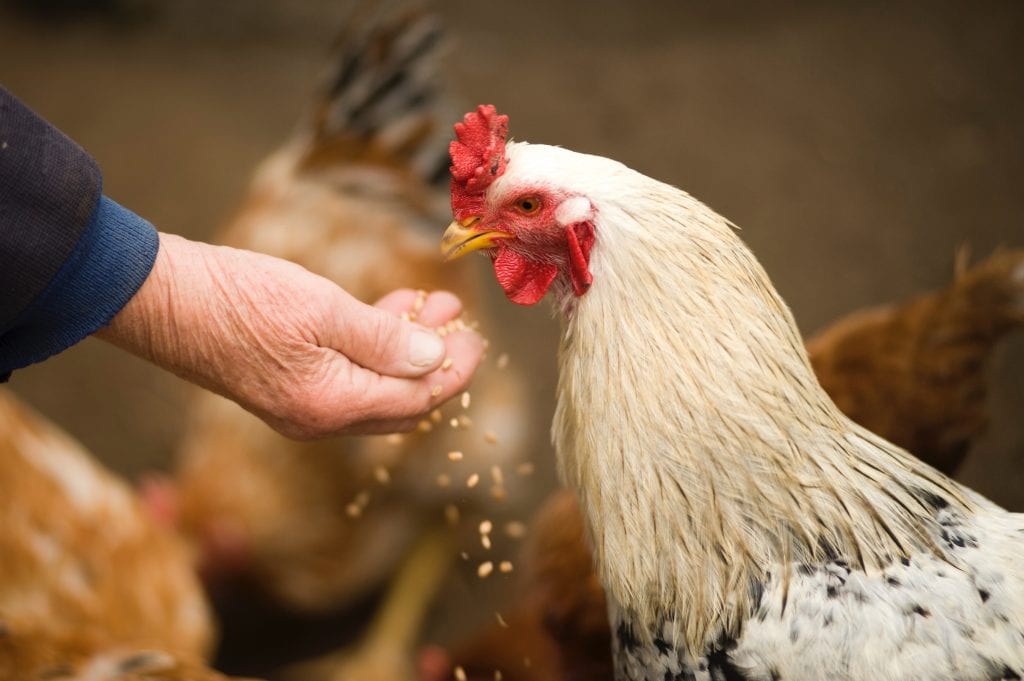
Regular consumption of foods naturally high in long chain omega-3 fatty acids have been shown to help raise HDL (the good) cholesterol, lower triglycerides, and may have a role in moderating the inflammatory process- thus reducing the likelihood of atherosclerosis, arthritis, diabetes, and other so-called Western diseases.[44,45,46,47] An interesting common denominator among foraging populations and non-Western pastoralists who generally have no signs of metabolic disease it is that their animal protein sources all contain naturally high levels of long chain omega-3 fatty acids.[20,35] Most studies cataloging the benefits of omega-3 fatty acids in humans point to the long chain forms, eicosapentaenoic acids (EPA) and docosahexaenoic acids (DHA). Simply stated, the longer chain forms of omega-3’s are easily used by our bodies while the shorter chain forms such as alpha linolenic acid (ALA) are not as biologically available to us. Alpha linolenic acids are found in plants and we are unable to efficiently convert them into their longer chain components, but chickens and other animals can. Free living chickens don’t plants, but they do eat insects and other invertebrates whose do eat plants and leaves. Chickens are then able to convert some of the alpha linolenic acids (ALA’s) from the plant sources into the longer chain forms that our bodies can use- eicosapentaenoic acids (EPA) and docosahexaenoic acids (DHA). When chickens were removed from fields, confined and fed a diet based on corn and soy a major alteration in their fat content occurred. Corn and other grains are seeds- which are high in the short chain linolenic acids (LA) which cannot be converted to the long chain forms of omega-3 fatty acids. In so doing an essential source of healthy fatty acids was removed from our diets.[48]
Chicken & Possible Increased Incidence Of Depression
Long chain omega-3 fatty acids are dietary substrates essential for the formation of brain tissue [88] and many evolutionary theories surmise that its addition to the diet of primates may have been key to the increase in brain size and neurological development that made us human.[9] That being said, our current intake from animal sources is far different than in our evolutionary past given the pervasive use of seed based oils today and the shift in feeds to chickens from their natural habits to corn and soy based diets.[49,50] Research surmises that lower dietary intake of those long chain omega-3’s from natural sources could be a factor in the prevalence of unipolar depression in the Western World as many studies have found correlations between long chain omega-3 fatty acid intake and increased incidences of depression.[51,52,53]
Depression affects an estimated one in ten Americans every year and this disorder accounts for more disability adjusted lost years in the world population than heart disease, lung cancer or AIDS and is a debilitating neuropsychiatric disorder that has increased substantially during the past one hundred years.[54, 55] Meta-analysis of several studies have found a direct link between the omega-3 fatty acid EPA and a reduction in the incidence of depression,[32] and it bears noting that intakes of long chain omega-3 fatty acids similar to levels obtained from wild protein sources throughout the better part of the human evolutionary experience may be an integral component of mental health. Incidences of depression are far lower in hunter gatherer societies who eat free living animal protein sources that are naturally high in long chain omega-3 fatty acids, and while it is difficult to separate the impact of lifestyle on depressive disorders it is hard to ignore the links which are being given serious consideration in the scientific community. [33]
Is Free Range Chicken As Good As Free Living Chicken?
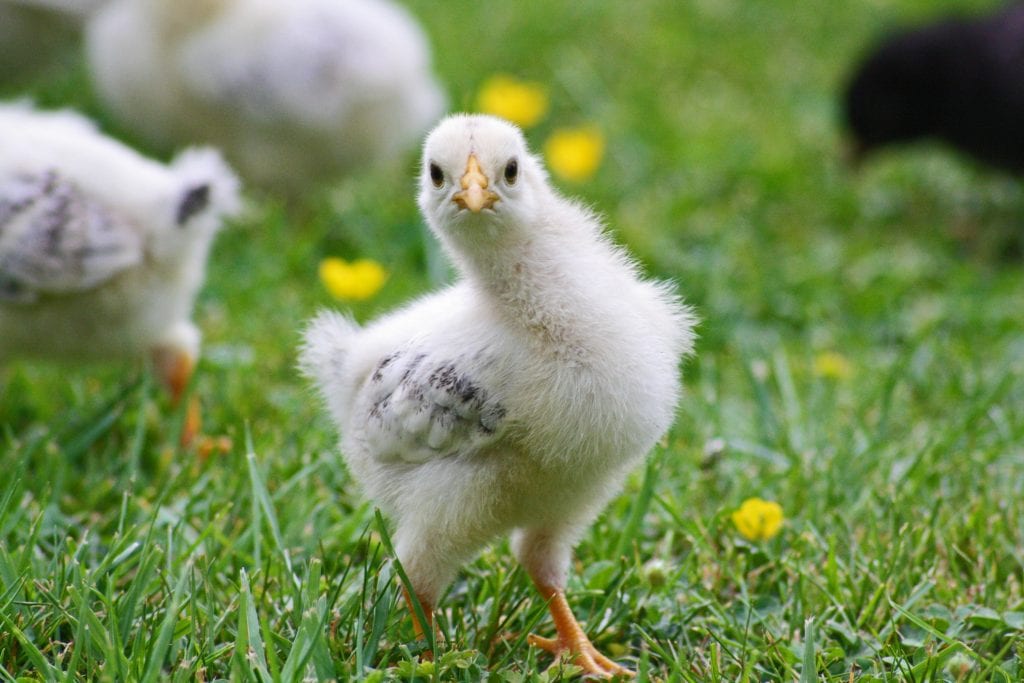
Nutrient comparisons of free range and certified organic chicken versus commercially raised chickens have found that free range chickens have only slightly higher levels of polyunsaturated fats and lower levels of saturated fats.[34] Other than that, all other nutrient profiles are the similar and the conclusion is that aside from consumer taste preferences, no real nutritional differences exist between certified organic free range chicken and commercially raised chicken[34] but there is one major flaw with these studies as they were done only on relatively large scale farms with no comparisons between ‘free range chickens’ and free living chickens which have dramatically different fat profiles due to food and lifestyle differences. Without appropriate controls it is impossible to extrapolate any useful data since there are such major differences between truly free living chickens and certified ‘free range’ ones. The term ‘free range’ by no means replicates the natural food supply or exercise habits of a truly wild bird. Anyone with a modicum of experience with truly free range chicken knows that even the most expensive ‘certified organic’ and ‘free range’ chicken stocked in ‘health conscious’ supermarkets are nothing like the ones you would find on a real farm. Not even close.
According to the US Department of Agriculture, the term ‘free range’ only requires that chickens have access to the outside. There is no stipulation as to how large this outside area needs to be, how many birds are allowed per acre, nor whether that outside access is to grass or gravel.[76] The ‘free range label’ also carries no indication of how much exercise the chickens get or where their primary food source comes from. For the most part ‘free range’ chickens are raised either with limited access to the outside in special houses and are by no means the bucolic image the term tries to present of birds roaming free in a beautiful pastoral environment. As such, it makes sense that the fat and nutritional profiles of ‘free range’ chickens would be similar to that of commercially raised ones as they are not that different when it comes down to food sources. Another element that underscores the case that ‘free range’ chicken is by no means the same as free living ones comes from even the most cursory examination of their bones. The primary method for determining the activity level of any animal is by measuring bone density, since bone size and structure are highly responsive to the mechanical demands placed on them.[77] As a rule, the more physically active an animal is, the more robust its bones will be.[77] That being said, even the most superficial examination of the tough and almost unbreakable bones of a truly free living chicken will confirm that there is a world of difference between them and the soft and easily snapped bones of the most expensive ‘free range’ birds. Differences that don’t stop manufacturers from charging as much as $2 to $3 per pound higher for having that label on the package.
Certified Organic Chicken- Is It Really That Much Better?
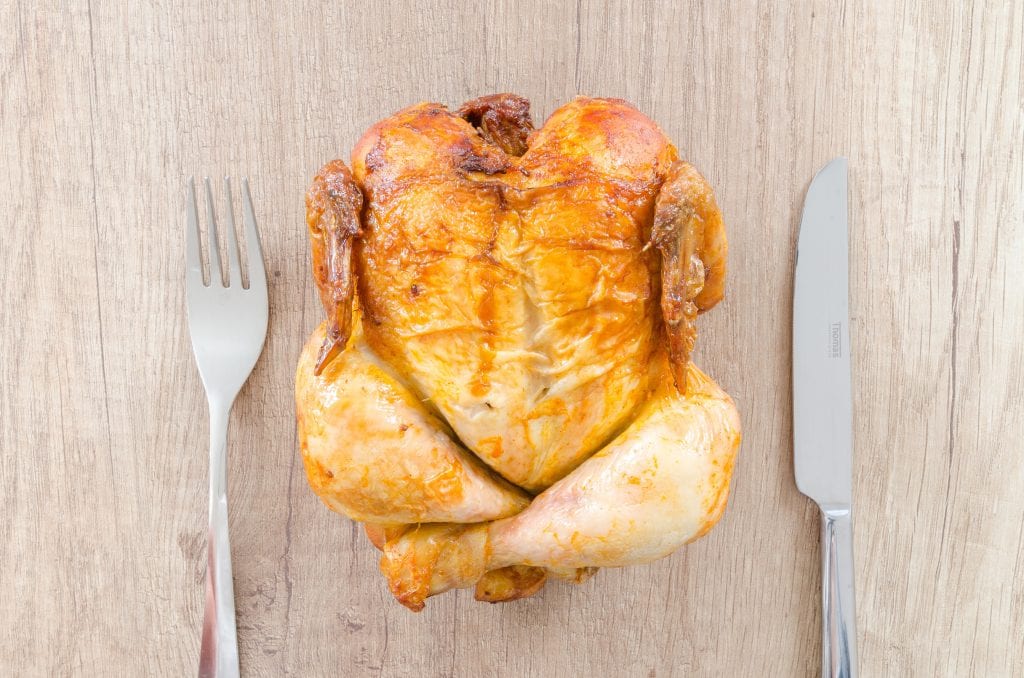
Muscle content is far higher among free living chickens, so much so that eating them can be a true exercise for your jaw given their inherent toughness. Toughness that comes from the higher muscle mass associated with higher physical activity levels. Greater muscle mass that equates to higher levels of healthy polyunsaturated and monounsaturated fats and relatively less naturally occurring saturated fats. That both ‘free range’ and ‘certified organic’ chicken has the same flesh consistency as commercially raised chickens should make anyone question the diet and activity level of these birds. As stated in the previous article Eating Meat- What You Need To Consider, the term ‘certified organic’ is limited in meaning. Certified organic chicken are required to follow certain minimal standards established by the USDA, namely that no antibiotics or growth producing hormones may be used, all grain must be ‘100% organic’ and free of animal products and the chickens must have ‘access to sunlight’ and have freedom of movement. We have already established that access to sunlight and pasture has nothing to do with how active the birds actually are and the guideline requirements make no mention of how much of the birds’ diet comprises of corn based grains and how much comes from their having adequate space and pasture to actually roam and find their own food.[85]
Furthermore, the idea of chickens having a 100% vegetarian diet in itself is inherently unnatural as they are omnivorous by nature. Making matters worse, the supposedly 100% certified organic grain they are supposed to be fed contains synthetic methionine- which is by no means organic. The USDA allows synthetic methionine in organic chicken feed because without it the chickens would not survive since they are not vegetarian.[78] Chickens have evolved to eat a diet that contains some amounts of non-vegetable based proteins from insects, worms, and small animals. Sources that naturally contain the amino acid methionine- which plays a major role in protein synthesis, egg production, optimum egg size, growth performance and feed efficiency.[79,80] Conventionally raised chickens are given feed with ground fish and other animals added to it, but synthetic methionine is a far cheaper alternative.[78] In a perfect world, the term 100% organic would not be used but at this point it would be safe to say that increasing sales by making consumers feel better about their purchases is far more important than honest labeling. Essentially, these certified organic rules are about farming that emphasizes the use of renewable resources and conservation of soil and water and not about raising chicken that is as natural as possible. The USDA makes no claim that organically produced chicken is safer or more nutritious than conventionally produced ones, [81] and in some respects certified organic chicken may even be more harmful to your health than conventional ones.
Certified Organic Chicken Has Higher Levels Of Harmful Bacteria Than Conventional Chicken
Most consumers perceive certified organic chickens as being safer and harboring less pathogenic bacteria as a result of the ‘more natural conditions’ in which they are raised, yet even this perception is incorrect. Published studies on the bacterial quality of free range and certified organic chickens consistently report that conventionally raised chickens have lower levels of Salmonella and Campylobacter.[82,83] How could certified organic chickens have higher bacterial counts than conventional ones? To start, greater access to the outside can mean greater exposure to wild birds, insects, rodent droppings and other carriers of Salmonella bacteria.[82] Also the so called 100% organic grain is grown without the use of chemicals which means they rely heavily on animal waste based fertilizers- which can also increase the likelihood of contamination.[82] Not a pretty picture but the reality of chicken farming today nevertheless. Other than a less confined space, studies find that there is nothing about the growing conditions of free range or organic chickens that would reduce the probability of Salmonella or any other enteric pathogens.[82,83]On the contrary, a report from the USDA Food Safety and Inspection Service found that 31% of free range chickens and 25% of ‘all natural’ chicken were contaminated with Salmonella, whereas the industry standard for Salmonella in conventional commercial chickens is only 12.8%.[84]
If you stop to consider for a moment that the reason chicken was so expensive before the advent of commercial farming because of the space required, it stands to reason that it is impossible to supply enough poultry to satisfy the needs of millions of consumers in a way that allows chickens roam free and eat their natural diets. Problems with space, increased labor costs, attrition due to predators and current consumer demand for tender, fatty chicken at a low cost make such ideas all but impossible, but it does not stop the meat industry from doing their best to create an image of their products being raised on family farms where they live great lives before being harvested.
Don’t Always Believe What’s On The Label
The industry has other methods of persuading consumers that their chickens are of higher quality and thus merit higher prices. Several brands label their chicken as ‘All Natural’- a term that means only that that there are no artificial chemicals or ingredients in the packaged product and that it was minimally processed.[85] Any company using that label should be suspect as it means that they are not even able to meet the requirements for the ‘certified organic’ label- which as we have noted is not as impressive as we might like them to be. Inspections are not required to verify any aspect of an ‘all natural’ claim and it has nothing to do legally with the food the chickens were fed, or the conditions in which they were raised.[86]
Other terms such as ‘raised without antibiotics’ are equally questionable. Realizing the public outrage over the use of antibiotics and the potential for increased sales and higher prices, chicken companies have in the past injected their eggs with antibiotics. In so doing they technically stayed true to the idea of their chickens being ‘raised without antibiotics’ while still reaping the antibiotic driven benefits of increased growth and reduced incidence of disease.[87] An unethical tactic to say the least, but in an environment where the onus is on increasing profit margins it is hardly surprising.
What Are Your Options

Given the rather dismal report, what would be the best options for an individual focused on their health? The answer is not as simple as we might like it to be as it is a personal question that we each have to ask, weighing in what’s best for our health and the environment. For many, it also comes down to a matter of economics as you simply cannot expect truly higher quality and truly natural chicken without higher prices. Currently, the price of certified organic chicken averages about $4.69 a pound while conventional chicken costs far less at $1.06 a pound- the lowest price for animal protein anywhere in the world thanks to commercial farming techniques and government subsidies.[44] In practical terms that comes down to a choice between a whole organic chicken costing around $20 or a conventional one costing less than $5- a challenging decision when income is limited and you understand that the certified organic label is often a case of all that glitters isn’t gold. Prices are even higher per pound for skinless boneless chicken breasts which we should all recognize is perhaps the newest animal protein addition to our collective diet as at no other time in history did humans eat chicken breasts without bones or skin. No native culture living close to the earth ever did and they do better than us here in the West with regards to adverse diet related health outcomes.
In the end it comes down to an understanding of the shortcomings and compromises that are required to mass produce enough chicken to meet the demands of the developing world- compromises that are conveniently glossed over by public relations campaigns and questionable marketing practices. As comprehensive as this article may seem it doesn’t even begin to touch on the social and ethical questions that the current industry raises. Nor does it address the dangers of having but a few corporations mostly in charge of our chicken supply as these questions must be considered as well. It goes without saying that large scale factory farms will continue to be the predominant source of chicken as consumers prefer to focus on factors like pricing, availability and convenience while overlooking the methods used. Words like “organic”, “free range” and “natural” help reduce any sense of the Frankensteinian aspects of modern commercial farming catering to large populations, but it doesn’t change the fact that the chicken you are eating isn’t anything like what your great grandparents may have been eating. What’s the solution? For some it’s an avoidance of chicken and meat altogether. Chicken isn’t needed for optimal health and given the sedentary lifestyle of most people in Westernized societies, meeting recommended protein requirements without eating chicken every day is not that difficult. For those who wish to keep eating chicken, it’s important to realize that there are still small family farms who work directly with independent butcher shops, farmers markets and farm to table restaurants. Small farmers face enormous pressure from large conglomerates, which is why it’s so important to buy from retailers and restaurants who source from small farms. As it not only helps support these hard-working men and women, but also supports a system where animals are raised in a more humane fashion. By giving more economic power small farmers, we also encourage more people to follow in their footsteps. Working on a farm is not easy, and it’s up to us to make it such that it allows those who do to be able to make a living as it’s the only way to have the healthy and better tasting chicken that our forefathers enjoyed. It takes a little more effort, and isn’t as easy as going to the local organic supermarket, and might cost a little more, but trust me it is worth it.
High Intensity Bodyweight Training: Ballistic Pushups & Dips!
This was a tough one!
Starts out with ballistic push ups (like clap pushups but without the clap as my wrist is still not 100%) nonstop for 20 reps, then all out on dips for 10 reps.
To say it was painful would be an understatement, but you just have to push through and keep on going.
Still training, hope you are too and as always, Excelsior!!! #naturallyintense
#hometraining #homeworkout #homeworkout #highintensitytraining #naturalbodybuilder #naturalbodybuilding #fitover40 #naturalbodybuildingvideos #chestday #chesttraining #naturalbodybuildingtips #pushups #dips #bodyweighttraining #highintensitytrainingtips #drugfreebodybuilding #calesthenics
Kevin's Unconventional Biceps Training- 3-6 Minutes a Week!
In this video I go over my biceps training using the Naturally Intense High Intensity Training protocols that helped me go from having arms measuring 11.5 to 12 inches to 18 inches drug free!
It's an unconventional approach for certain, but it's one that's helped my arms grow and the hundreds of men and women I have trained over the past 30 plus years.
Now, my success isn't due to being genetically gifted, as it took me the better part of 11 years to get my arms up to those measurements.
Which is significant as it works and been been proven time and time again to work for the average man or woman trying to grow their arms without drugs.
It's my hope that these high intensity training protocols can help you as much as they helped me!
Click on my bio link to see the full video on my YouTube channel and thanks as always for taking the time to look at my work!!! Excelsior!!! #naturallyintense
#highintensitytraining #naturalbodybuilder #naturalbodybuilding #fitover40 #naturalbodybuildingvideos #armworkout #bicepsworkout #naturalbodybuildingtips #biceps #armtraining #highintensitytrainingtips #drugfreebodybuilding #barbellcurls
At the Lancaster Classic Day 2 Elimination Rounds Against European Champion, and World Record Holder Leo Pettersen @leo_barebow_archer
I don't talk much about it but I'm also a competitive barebow archer (surprise!) and last Saturday I had the honor of making it to Day 2 at the Lancaster Archery Classic in the Barebow Division, as I made the top 64 out of 267 competitors and had a chance to shoot with some of the greatest barebow shooters on the planet!
I didn't make it past Leo, but it was a real rush to be there and a huge thanks to my coach, Joe MyGlyn @prolinearchery for helping me get there.
Thanks as well to my good friend @sean_chan33 for all of his help from the very start, to my line buddy Aaron Shea for taking the shot and showing up to support!
My thanks as well to rob_kaufhold for putting on and promoting one of the best archery tournaments on earth!
Thanks also to to everyone who took the time to send a supporting word and I am looking forward to next year!!! #naturallyintense #barebow
#lancasterclassic #lancasterarcheryclassic2024 #lancasterarchery #archery #fitover40 #barebowrecurve #targetarchery
Dumbo, Brooklyn circa 2004
This shot was taken as part of the promotion for my Naturally Intense DVD and was about a year after my last bodybuilding competition.
It was a grueling photoshoot.
We started at about 10 am and finished around 4pm and I was completely spent, but the more we shot the sharper I looked, so we kept on going.
It's nice to look back from time to time and as tired as I was, we all had a blast!
My thanks to @stephanie_corne_artwork, @https://pulse.ly/itgnag2dec and @ftaz1 for taking the shots!!!
Thanks for watching and as always, Excelsior!!! #naturallyintense
#naturalbodybuilder #naturalbodybuilding #throwback #fifthavenuegym #5thavenuegym #drugfreebodybuilding #naturalbodybuildinglifestyle #gymlife #gymmotivation #naturalbodybuildingmotivation #bodybuilding #blackandwhite #instablackandwhite #bnw
Can You Build An Impressive Physique Training Only At Home?
Absolutely!
I stopped training in commercial gyms as of March 2020 and have been training at home ever since.
Initially I was admittedly worried that I might lose some of my gains or not make as much progress, but that certainly wasn't the case.
I've consistently continued to improve with my high intensity workouts and muscles have no idea where they are training.
As long as the criteria of adequate intensity and overload are met, there will be an adaptive response and your muscles will get bigger and stronger.
So don't worry at all about where you train, focus instead of what will be the best way for you to always be training!
Thanks for watching and as always, Excelsior!!! #naturallyintense
Kevin's Three Day Training Spilt!
For the past 33 years I have trained three times a week with Naturally Intense High Intensity Training workouts lasting 10, 15 to 20 minutes max.
It's a training split tried and testes not only in it's helping me realize my goal of becoming a successful natural bodybuilder, but it's also helped hundreds of men and women over the past three decades.
I have tested just about every possible training split imaginable and for this particular style of high intensity training, this particular grouping consistently yields fantastic results.
I hope it helps you as much as it's helped me over the years and thanks so much for taking the time to look at my work.
Keep training hard and Excelsior!!! #naturallyintense
Excelsior!!! #naturallyintense
#trainingsplit #3daytrainingsplit #threedaytrainingsplit #naturalbodybuilding #naturalbodybuilder #naturalbodybuildingvideo #naturalbodybuildingmotivation #naturalbodybuildingtips #drugfreebodybuilding #bodybuilding #highintensitytraining #highintensitytrainingtips
405 Stiff Leg Deadlift for 7 Reps! High Intensity Training.
First leg workout of the year and already pushing it!
I haven't done a stiff leg deadlift over 315lbs for about 3 years at this point, and I did my last set with 315lbs and comfortably got to 10 reps and decided I had far too much gas left in the tank and that I should go up in weight.
So I did.
I figured I might get a solid 6 reps in, but I made it to 7 and I think I could have gone on to get a full 10 reps BUT that's when good judgement prevailed.
As a bodybuilder having not trained this heavy for so many years, the shock of this much weight would be more than enough to stimulate muscle growth, and doing more reps wouldn't yield any greater returns, only increase the likelihood of injury.
It's not about the numbers, it's about training to a point where you achieve your goal, and it's important to have a goal in mind as a bodybuilder based on increasing muscle mass rather than hitting a particular number.
Besides, if in my 20's I never did more than 405lbs on a stiff leg deadlift, it doesn't make any sense going heavier than when I am almost 50!
Could I deadlift more at this point?
Absolutely but just because you can doesn't mean you should!
So keep those weights in a good working range, keep it safe and as always Excelsior!!! #naturallyintense
#hometraining #homeworkout #homeworkout #roguerack #highintensitytraining #naturalbodybuilder #naturalbodybuilding #fitover40 #naturalbodybuildingvideos #backworkout #naturalbodybuildingtips #backtraining #highintensitytrainingtips #drugfreebodybuilding #fitoverforty #deadlift
Turning 50 in a few months...
Not much of a big deal for me as I still feel pretty much the same but I hope that my example helps show what can be done with a lifetime commitment to eating well and training consistently!
Thanks for coming along on the journey and as always, Excelsior!!! #naturallyintense
#naturalbodybuilder #naturalbodybuilding #healthylifestyle #fitover40 #drugfreebodybuilding #naturalbodybuildingmotivation #natty #fitness
Please note that all material is copyrighted and DMCA Protected and can be reprinted only with the expressed authorization of the author.
Featured everywhere from the Wall Street Journal to CBS News, Kevin Richardson’s Naturally Intense High Intensity Training have helped hundreds lose weight and transform their bodies with his 10 Minute Workouts. One of the top natural bodybuilders of his time, Kevin is also the international fitness consultant for UNICEF and one of the most sought after personal trainers in New York City. Click to learn more about his personal training NYC
Related Articles & Resources:
Read Part One Of The Series: Eating Meat- What You Need To Consider Here
References For Should You Be Eating Chicken:
1. DD Stull, MJ Broadway. Slaughterhouse Blues: The Meat and Poultry Industry in North America (Case Studies on Contemporary Social Issues) Cengage Learning. 2003
2. The National Chicken Council Per Capita Consumption of Poultry and Livestock, 1965 to Estimated 2013, in Pounds
3. The United States Meat Industry at a Glance. The American Meat Institute (AMI) 2013
4. L Cordain, SB Eaton, A Sebastian, N Mann, S Lindeberg, BA Watkins, JH O’Keefe, J Brand-Miller. Origins and evolution of the Western diet: health implications for the 21st century. Am J Clin Nutr. 2005
5. Food-Disparagement Laws: State Civil & Criminal Statutes Coalition for Free Speech Food Speak 1998
6. WH Williams Delmarva’s chicken Industry: 75 Years of Progress. Delmarva’s Poultry Industry 1998
7. NT Boaz. Evolving health: the origins of illness and how the modern world is making us sick. New York: Wiley & Sons, Inc, 2002. Nesse RM, Williams GC. Why we get sick. The new science of Darwinian medicine. New York: Times Books, 1994.
8. SB Eaton, MJ Konner. Paleolithic nutrition. A consideration of its nature and current implications. N Engl J Med 1985
9. SB Eaton, M Konner, M Shostak. Stone agers in the fast lane: chronic degenerative diseases in evolutionary perspective. AmJ Med 1988
10. L Cordain, RW Gotshall, SB Eaton. Physical activity, energy expenditure and fitness: an evolutionary perspective. Int J Sports Med 1998
11. L Cordain. Cereal grains: humanity’s double edged sword. World Rev Nutr Diet 1999
12. MN Cohen.Health and the rise of civilization. London: Yale University Press, 1989.
13. HL Abrams. The relevance of Paleolithic diet in determining contemporary nutritional needs. J Appl Nutr 1979
14. AS Truswell. Diet and nutrition of hunter-gatherers. In: Health and disease in tribal societies. New York: Elsevier; 1977
15. L Cordain, BA Watkins, GL Florant, M Kehler, L Rogers, Y Li. Fatty acid analysis of wild ruminant tissues: evolutionary implications for reducing diet-related chronic disease. Eur J Clin Nutr 2002
16. L Frassetto, RC Morris Jr, DE Sellmeyer, K Todd, A Sebastian. Diet, evolution and aging—the pathophysiologic effects of the post agricultural inversion of the potassium-to-sodium and base-to-chloriden ratios in the human diet. Eur J Nutr 2001
17. American Heart Association. Heart and stroke statistics—2004 update. Dallas: American Heart Association, 2003.
18. Deaths: Preliminary Data for 2011. National Vital Statistics Reports- Centers for Disease Control and Prevention’s National Center for Health Statistics 2012
19. J Diamond- The World until Yesterday. What Can We Learn From Traditional Societies- Viking Adult 2012
20. L Cordain, SB Eaton, JB Miller, N Mann, K Hill. The paradoxical nature of hunter-gatherer diets: meat-based, yet non-atherogenic. Eur J Clin Nutr. 2002
21. Long 1991, VS Long. Tyson Food Empire Had Its Start Between Fruit Handling Seasons. Kansas City Star 1991
22. JM Morrison The Poultry Industry: A View of the Swine Industry’s Future? Pigs Profits & Rural Communities 1998
23. S Schoenborn. Pew Campaign, Health Care Without Harm Push for End Of Overuse of Antibiotics in Animal Ag. Ag Weekly 2010
24. Report on the Policy Commission on the Future of Farming and Food 2002
25. SB Levy, GB FitzGerald, and AB Macone. Changes in Intestinal Flora of Farm Personnel after
Introduction of a Tetracycline‐Supplemented Feed on a Farm. New England Journal of Medicine 1976 26. KE Smith, JM Besser, CW Hedberg, FT Leano, JB Bender, JH Wicklund, BP Johnson, KA Moore, and MT Osterholm. Quinolone‐resistant Campylobacter jejuni infections in Minnesota, 1992‐1998. New England Journal of Medicine 1999
27. R Young, A Cowe, C Nunan, J Harvey L Mason. The Use and Misuse of Antibiotics in U.K. Agriculture. Soil Association 1999
28. F Angulo, KR Johnson, RV Tauxe, ML Cohen. Origins and Consequences of Antimicrobial Resistant Non Typhoidal Salmonella: Implications for the use of Fluoroquinolones in Food Animals. Microbial Drug Res. 2000
29. HT Buxton, DW Kolpin. Fact Sheet FS-027-02, Pharmaceuticals, Hormones and other Organic wastewater Contaminants in US Streams- US Geological Survey 2002
30. M Mellon, C Benbrook, KL Benbrook. Hogging It. Estimates of Antimicrobial Abuse in Livestock. Union of Concerned Scientists 2001
31. Kris-Etherton PM, Harris WS, Appel LJ. Fish consumption, fish oil, omega-3 fatty acids, and cardiovascular disease. Circulation 2002
32. Martins JG. EPA but not DHA appears to be responsible for the efficacy of omega-3 long chain polyunsaturated fatty acid supplementation in depression: evidence from a meta-analysis of randomized controlled trials. J Am Coll Nutr. 2009
33. Albanese E, Lombardo FL, Dangour AD, Guerra M, Acosta D, Huang Y, Jacob KS, Llibre Rodriguez Jde J, Salas A, Schönborn C, Sosa AL, Williams J, Prince MJ, Ferri CP. No association between fish intake and depression in over 15,000 older adults from seven low and middle income countries–the 10/66 study.PLoS One 2012
34. R Husak, JG Sebranek.A Survey of Commercially Available Broilers Originating from Organic, Free-range, and Conventional Production Systems for Meat Yield, Composition, and Relative Value. Animal Industry Report 2007
35. SB Eaton, Humans, Lipids and evolution. Lipids 1992
36. PS Ungar, MF Teaford. Human Diet- It’s Origin and Evolution. Bergin & Garvey CT 2002
37. Mensink RP, Zock PL, Kester ADM, Katan MB. Effects of dietary fatty acids and carbohydrates on the ratio of serum total to HDL-cholesterol and on serum lipids and apolipoproteins: a meta-analysis of 60 controlled trials. Am J Clin Nutr 2003
38. Kromhout D, Menotti A, Bloemberg B, et al. Dietary saturated and trans fatty acids and cholesterol and 25-year mortality from coronary heart disease: the Seven Countries Study. Prev Med 1995
39. Soinio M, Laakso M, Lehto S, Hakala P, Ronnemaa T. Dietary fat predicts coronary heart disease events in subjects with type 2 diabetes. Diabetes Care 2003
40. Hu FB, Stampfer MJ, Manson JE, et al. Dietary saturated fats and their food sources in relation to the risk of coronary heart disease in women. Am J Clin Nutr 1999
41. Ascherio A, Rimm EB, Giovannucci EL, Spiegelman D, Stampfer M, Willett WC. Dietary fat and risk of coronary heart disease in men: cohort follow up study in the United States. BMJ 1996
42. Oh K, Hu FB, Manson JE, Stampfer MJ, Willett WC. Dietary fat intake and risk of coronary heart disease in women: 20 years of follow-up of the Nurses’ Health Study. Am J Epidemiol 2005
43. Siri-Tarino PW, Sun Q, Hu FB, Krauss RM. Meta-analysis of prospective cohort studies evaluating the association of saturated fat with cardiovascular disease. Am J Clin Nutr. 2010
44. DR Simon. Meatonomics: How the Rigged Economics of Meat and Dairy Make You Consume Too Much-and How to Eat Better, Live Longer, and Spend Smarter. Conari Press 2013
45. Harris, William S. “n−3 fatty acids and serum lipoproteins: human studies”. Am J Clin Nutr 1997
46. Sanders, T.A.B.; Oakley, F.R.; Miller, G.J.; Mitropoulos, K.A.; Crook, D.; Oliver, M.F. “Influence of n−6 versus n−3 polyunsaturated fatty acids in diets low in saturated fatty acids on plasma lipoproteins and hemostatic factors”. Arteriosclerosis, Thrombosis, and Vascular Biology 1997
47. Roche, H.M.; Gibney, M.J. “Postprandial triacylglycerolaemia: the effect of low-fat dietary treatment with and without fish oil supplementation”. Eur J Clin Nutr. 1996
48. A Trebunová, A.; Vasko, L.; Svedová, M.; Kasteľ, R.; Tucková, M.; Mach, P. “The influence of omega-3 polyunsaturated fatty acids feeding on composition of fatty acids in fatty tissues and eggs of laying hens”. Deutsche Tierärztliche Wochenschrift. 2007
49. J Woods, G Ward, N Salem Jr. Is docosahexaenoic acid necessary in infant formula? Evaluation of high linolenate diets in the neonatal rat. Pediatr Res. 1996
50. N Salem Jr, B Wegher, P Mena, R Uauy. Arachidonic and docosahexaenoic acids are biosynthesized from their 18-carbon precursors in human infants. Proc Natl Acad Sci U S A. 1996
51. MA Beydoun, MT Fanelli Kuczmarski, HA Beydoun, JR Hibbeln, MK Evans, AB Zonderman. Omega-3 Fatty Acid Intakes Are Inversely Related to Elevated Depressive Symptoms among United States Women. J Nutr. 2013
52. LA Colangelo, K He, MA Whooley, ML Daviglus, K Liu. Higher dietary intake of long-chain omega-3 polyunsaturated fatty acids is inversely associated with depressive symptoms in women. Nutrition. 2009 53. K Murakami, Y Miyake, S Sasaki, K Tanaka, M Arakawa. Fish and n-3 polyunsaturated fatty acid intake and depressive symptoms: Ryukyus Child Health Study. Pediatrics. 2010
54. Murray CJ, Lopez AD. Evidence-based health policy–lessons from the Global Burden of Disease Study. Science. 1996
55. Klerman GL, Weissman MM. Increasing rates of depression. JAMA. 1989
56. Biss K, Ho KJ, Mikkelson B, Lewis LA & Taylor CB: Some unique biological characteristics of the Masai of east Africa. New Engl. J. Med.1971
57. PS Bridges: Skeletal biology and behavior in ancient humans. Evol. Anthropol 1995
58. Cordain L, Brand Miller J, Eaton SB, Mann N, Holt SHA & Speth JD: Plant-animal subsistence ratios and macronutrient energy estimations in worldwide hunter-gatherer diets. Am. J. Clin. Nutr 2000
59. Day J, Carruthers M, Bailey A & Robinson D : Anthropometric, physiological and biochemical differences between urban and rural Maasai. Atherosclerosis 1976
60. Dietz WH, Marino B, Peacock NR & Bailey PH: Nutritional status of Efe pygmies and Lese horticulturalists. Am. J. Phys.Anthropol. 1982
61. Hawkes K, Hill K & O’Connell JF: Why hunters gather: optimal foraging and the Ache of eastern Paraguay. Am. Ethnol. 1982
62. Hayden B: Subsistence and ecological adaptations of modern hunter=gatherers. In Omnivorous Primates, ed. RSO Harding & G Teleki, New York: Columbia University Press. 1981
63. Hurtado AM & Hill K: Early dry season subsistence ecology of the Cuiva (Hiwi) foragers of Venezuela. Hum. Ecol. 1986
64. Lee RB : The !Kung San: Men, Women, and Work in a Foraging Society. Cambridge: Cambridge University Press 1979
65. McArthur M: Food consumption and dietary levels of groups of aborigines living on naturally occurring foods. In Records of the American-Australian Scientific Expedition to Arnhem Land, ed. Melbourne: Melbourne University Press 1960
66. Hu FB, Stampfer MJ, Manson JE, Ascherio A, Colditz GA, Speizer FE, Hennekens CH & Willett WC: Dietary saturated fats and their food sources in relation to the risk of coronary heart disease in women. Am. J. Clin. Nutr.1999
67. Hu FB, Rimm EB, Stampfer MJ, Ascherio A, Spiegelman D & Willett WC: Prospective study of major dietary patterns and risk of coronary heart disease in men. Am. J. Clin. Nutr 2000
68. Menotti A, Kromhout D, Blackburn H, Fidanza F, Buzina R & Nissinen A: Food intake patterns and 25-year mortality from coronary heart disease: cross-cultural correlations in the Seven Countries Study. The Seven Countries Research Study Research Group. Eur. J. Epidemiol. 1999
69. Popkin BM, Siega-Riz AM, Haines PS & Jahns L: Where’s the fat? Trends in U.S. diets 1965 – 1996. Prev. Med 2001
70. Barnard ND, Nicholson A & Howard JL : The medical costs attributable to meat consumption. Prev. Med 1995
71. Intake of Calories and Selected Nutrients for the United States Population, 1999-2000. NHANES Center for Disease Control & Prevention
72. Garg A, Bonanome A, Grundy SM, Zhang Z-J & Unger RH: Comparison of a high-carbohydrate diet with a high-monounsaturated fat diet in patients with non-insulin dependent diabetes mellitus. New Engl. J. Med. 1988
73. Nelson GJ, Schmidt PC & Kelley DS: Low-fat diets do not lower plasma cholesterol levels in healthy men compared to high fat diets with similar fatty acid composition at constant caloric intake. Lipids 1995
74. Gardner CD & Kraemer HC: Monounsaturated versus polyunsaturated dietary fat and serum lipids. A meta analysis. Arterioscler. Thromb. Vasc. Biol. 1995
75. Mensink RP & Katan MB (1992): Effect of dietary fatty acids on serum lipids and lipoproteins: a meta-analysis of 27 trials. Arterioscler. Thromb. 1992
76. Connor SL & Connor WE: Are fish oils beneficial in the prevention and treatment of coronary artery disease? Am. J. Clin. Nutr. 1997
77. Larsen 1997 Bioarchaeology: Interpreting Behaviour from The Human Skeleton. Cambridge University Press
78. Halder, G, B. Roy. Effect of herbal or synthetic methionine on performance, cost benefit ratio, meat and feather quality of broiler chicken. Int. J. Agric. Res 2007
79. Aerni V, Brinkhof MWG, Oester WH, Frohlich E. Productivity and mortality of laying hens in aviaries: a systematic review. World Poult. Sci. J. 2005
80. Binder M. Life cycle analysis of DL-methionine in broiler meat production. In: Information for the feed industry. Degussa feed additives, Hanau-Wolfgang, Germany 2003
81. Bailey J.S., Cosby E. Salmonella Prevalence in Free Range and Certified Organic Chickens. Journal of Food Protection 2005
82. Bailey & Cosby, AL Izat, JM Kopek, JD McGinnis. Research note: incidence, number and serotypes of salmonella on frozen broilers at retail. Poult Sci 1991
83. OE Heuer, JS Pedersen, JS Andersen, M Madsen/ Prevalence and antimicrobial susceptibility of thermophilic Campylobacter in organic and conventional broiler flocks. Lett. Appl. Microbiol. 2001
84. USDA Food Safety and Inspection Service Reports 2000 to 2003
85. USDA’s Food Safety and Inspection Service
86. M Nestle. What To Eat. North Point Press; 1st edition 2007
87. Guiterez 2008, Animal Welfare Approved 2010
88. MA Crawford, SC Cunnane, LS Habrige. A new theory of evolution: Quantum theory. In A Sinclair, R Gibson (eds) Essential Fatty Acids and Eicosaniods. American Oil chemists Society 1992




